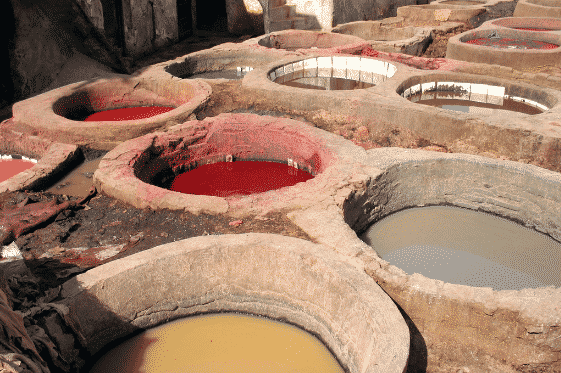
Dyeing process & Finishing
Dyeing process
The leather dyeing process is what adds the wonderful colour to a finished leather design. This can be anything from the browns and blacks associated with leather to bright, bold colours. Each dye is meticulously formulated using a highly accurate computer program, without which it would be impossible to get a consistent colour each time.
The actual dyeing process can be incredibly lengthy with hides needing to be added to a large drum along with their chosen dye for a long period of time to ensure the dye takes. After around 8 hours a cutting should be taken to ensure that the dye has completely saturated the hide. Otherwise, the leather will look patchy. Afterwards the leather needs to be rinsed thoroughly to remove any residual dye or chemicals. Once rinsed the hide should be dried entirely.
FINISHING
When the dyeing process is complete, the last stage in the leather-making is the finishing. This is the stage where the leather will be worked to ensure that it has the supple, flexible nature that is so desired in leather as well as the glossy finish. A finish that not only protects the surface but also one which can be easier to clean. This stage would be skipped if a naked leather was desired.
To soften the leather a machine called a staker is used where the leather is both stretched and lots of natural oils will be added to lubricate the fabric. This stretching motion also tightens the pore structure of the leather. This helps create a higher quality finish that is desirable to consumers.


The final touch


The final touch is to apply a finishing spray on the leather. What the finishing spray is will depend on the desired finish of the leather. For instance, a coat of acrylic can be added for a patent leather finish, mother of pearl can be added to give a pearlescent finish and at this stage leather can be embossed with patterns. On a large-scale production, the leather will be hung and moved through the chosen spray line before being put into an oven to be cured. Once finished the leather can be stacked to prevent the leather getting creased and then it can be sent off ready to be used in making leather products. Full grain leathers, however, will skip this stage as it’s not needed. Instead, this leather will go through an ironing process, which will use varying degrees of pressure and heat until the desired sheen is obtained.
Last step
The last stage of the process will be a quality check to ensure the leather has the correct colour and that there are no tears or anomalies in the leather. From here the leather can be rolled and shipped ready to be turned into quality luggage, handbags or any other leather accessory.
This technique is the one that still today, after many years, our craftsmen continue to use to guarantee the wonderful colour of the models, which has always distinguished our market. Visit our online store and stay tuned for more industry information.